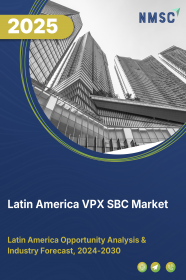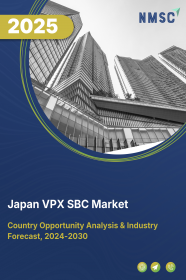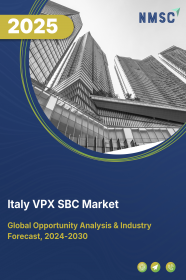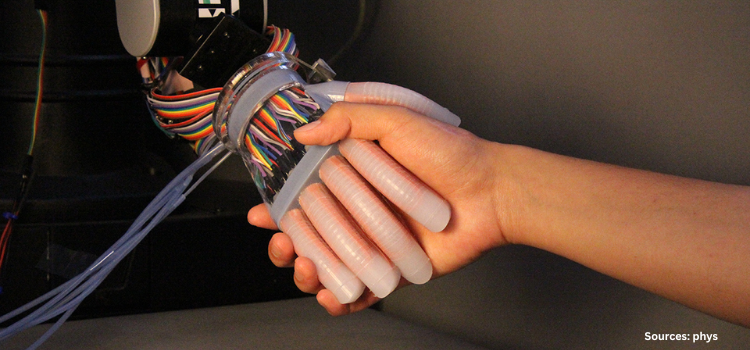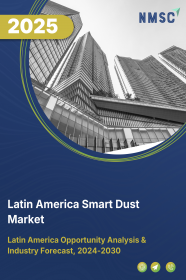
Latin America Smart Dust Market by Component (Sensors, Active Optical Transmission, Passive Optical Transmission, Optical Receiver, Analog I/O, Signal Processing, Control Circuitry, Power Source, and Others), by Manufacturing Process (3D Printing and Microfabrication), by Type (Biodegradable and Non-Biodegradable) and Others– Opportunity Analysis and Industry Forecast 2026-2030
Industry: Semiconductor & Electronics | Publish Date: 14-Feb-2025 | No of Pages: 127 | No. of Tables: 93 | No. of Figures: 58 | Format: PDF | Report Code : SE1931
Market Definition
The Latin America Smart Dust Market will value at USD 445.06 thousand in 2025 and is predicted to reach USD 1349.83 thousand by 2030, at a CAGR of 21.2% from 2026 to 2030. Present-day advanced technologies prioritize miniaturization and automation. The history of computing has been defined by increased connectivity, the decreasing size of computing devices, and enhanced communication with the world. The growing popularity of smaller computing devices such as mobile phones and handheld computers, alongside the development of micro sensors and micro transistors, has significantly accelerated the progression of further nano computing devices.
Consequently, heightened interaction with the environment and the emergence of small computing elements offers enriched opportunities to reshape interactions among computers, humans, and the environment. These factors have prompted the emergence of Smart Dust, which comprises various microelectromechanical systems (MEMS) including sensors and other devices capable of detecting light, temperature, magnetism, vibration, or chemicals, among other parameters. Typical Smart Dust consists of nano-structured silicon sensors that can autonomously orient, sense, assemble, and report on the environment it is placed in.
Integration of Smart Dust in the Medical Sector is Expected to Drive the Latin America Market in the Coming Years
The integration of smart dust into the medical sector is poised to revolutionize healthcare practices in the country in the years ahead. With its miniature size and wireless connectivity, smart dust sensors can be deployed within the human body to monitor various vital signs, detect early signs of disease, and even deliver targeted treatments. This technology enables real-time data collection, leading to more accurate diagnoses and personalized medical interventions. Additionally, the continuous monitoring facilitated by smart dust enhances preventive care and allows for timely interventions, ultimately improving patient outcomes and reducing healthcare costs. Consequently, the adoption of smart dust in the medical sector is anticipated to drive significant growth in the smart dust market as healthcare providers increasingly recognize its potential to transform the delivery of healthcare services.
Industrial Monitoring Capabilities of Smart Dust is Expected to Increase its Adoption in Latin America
The industrial monitoring capabilities of smart dust in the country are anticipated to drive its uptake to unprecedented levels. With its potential to furnish real-time data on various aspects of industrial operations, such as equipment performance, environmental conditions, and safety parameters, smart dust offers unparalleled insights for optimizing efficiency and productivity. By enabling continuous monitoring and proactive maintenance, smart dust helps businesses in reducing downtime, cutting operational costs, and improving overall performance. As industries worldwide aim for increased automation, efficiency, and sustainability, the demand for smart dust solutions is expected to skyrocket, fostering widespread adoption across diverse sectors from manufacturing and energy to transportation and logistics. This increased uptake is poised to transform industrial processes and pave the way for a smarter, more interconnected future.
Privacy Concerns Associated with Smart Dust Hinders the Latin America Market Growth
Concerns about privacy connected with smart dust present a substantial impediment to market development in the country. Despite the groundbreaking capabilities it offers for data collection and analysis, the continuous monitoring it enables gives rise to concerns about individual privacy and data protection. Users are concerned about the potential for unauthorized access to sensitive information gathered by smart dust sensors and the risk of covert surveillance. These concerns are further exacerbated by the widespread deployment of smart dust, prompting questions about consent and control over personal data. Consequently, individuals, businesses, and regulatory bodies are reluctant to fully embrace smart dust technology, hindering its market expansion as they seek effective solutions to address these privacy concerns.
Introduction of Smart Dust in Space Research is Expected to Create Ample Opportunities in the Latin America Market
Smart dust is anticipated to play a significant role in forthcoming space missions in the country. Nanosensors vastly enhance high-performance materials or highly efficient propulsion systems. Smart dust sensors could be deployed in space or on the surface of a terrestrial planet where conventional detection systems would be impractical or challenging to install. Various international space exploration organizations are engaged in diverse research and development endeavors regarding the utilization of nanoparticles such as smart dust to gather data during unmanned expeditions in outer space.
Conversely, conventional rocket engines rely on chemical propulsion, and all current spacecraft utilize some form of chemical rockets that require launching. Nevertheless, researchers and space organizations are advancing electric propulsion (EP) systems as they can substantially reduce the propellant mass needed in conventional chemical rockets, thereby increasing payload capacity while decreasing launch mass. Some electric propulsion (EP) concepts suggest employing electrostatically charged and accelerated nanoparticles as propellants, alongside using smart dust as sensor arrays. This enables millions of micron-sized nanoparticle thrusters to be integrated into one square centimeter, enabling the creation of highly scalable thruster arrays for future electric propulsion systems. The aforementioned applications of smart dust are projected to generate abundant opportunities in the future.
Competitive Landscape
Various market players operating in the Latin America smart dust market include HP, Cisco Systems Inc, Analog Devices, Lightricity Ltd, IBM, CubeWorks, SINTEF, Sonardyne International Ltd, General Electric, and Hitachi.
Latin America Smart Dust Market Key Segments
By Component
-
Sensors
-
Active Optical Transmission
-
Passive Optical Transmission
-
Optical Receiver
-
Analog I/O
-
Signal Processing
-
Control Circuitry
-
Power Source
-
Others
By Manufacturing Process
-
3D Printing
-
Microfabrication
By Type
-
Biodegradable
-
Non-Biodegradable
By Applications
-
Humidity Monitoring
-
Temperature Monitoring
-
Surveillance
-
Pressure & Stress Monitoring
-
Sound Monitoring
-
Others
By End User
-
Aerospace & Defense
-
Pharmaceutical & Lifesciences
-
Agriculture
-
Industrial
-
Government
-
Construction
-
Transportation & Logistics
-
Telecommunication
-
Others
REPORT SCOPE AND SEGMENTATION:
|
Parameters |
Details |
|
Market Size in 2025 |
USD 445.06 Thousand |
|
Revenue Forecast in 2030 |
USD 1349.83 Thousand |
|
Growth Rate |
CAGR of 21.2% from 2026 to 2030 |
|
Analysis Period |
2025–2030 |
|
Base Year Considered |
2025 |
|
Forecast Period |
2026–2030 |
|
Market Size Estimation |
Thousand (USD) |
|
Growth Factors |
|
|
Companies Profiled |
10 |
|
Customization Scope |
Free customization (equivalent up to 80 analysts working hours) after purchase. Addition or alteration to country, regional & segment scope. |
|
Pricing and Purchase Options |
Avail customized purchase options to meet your exact research needs. |
KEY PLAYERS
-
HP
-
Cisco Systems Inc.
-
Analog Devices
-
Lightricity Ltd.
-
IBM
-
CubeWorks
-
SINTEF
-
Sonardyne International Ltd.
-
General Electric
-
Hitachi

















 Speak to Our Analyst
Speak to Our Analyst



